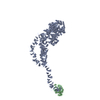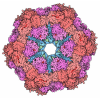+ Open data
Open data
- Basic information
Basic information
| Entry | Database: PDB / ID: 8ji0 | |||||||||||||||||||||||||||||||||
|---|---|---|---|---|---|---|---|---|---|---|---|---|---|---|---|---|---|---|---|---|---|---|---|---|---|---|---|---|---|---|---|---|---|---|
| Title | Cryo-EM structure of the TcsH-CROP in complex with TMPRSS2 | |||||||||||||||||||||||||||||||||
 Components Components |
| |||||||||||||||||||||||||||||||||
 Keywords Keywords | TOXIN/HYDROLASE / TcsH / TMPESS2 / TOXIN-HYDROLASE complex | |||||||||||||||||||||||||||||||||
| Function / homology |  Function and homology information Function and homology informationsymbiont-mediated disruption of host focal adhesion / transmembrane protease serine 2 / symbiont-mediated killing of host cell / host cell cytosol / detection of maltose stimulus / glycosyltransferase activity / maltose transport complex / carbohydrate transport / protein autoprocessing / carbohydrate transmembrane transporter activity ...symbiont-mediated disruption of host focal adhesion / transmembrane protease serine 2 / symbiont-mediated killing of host cell / host cell cytosol / detection of maltose stimulus / glycosyltransferase activity / maltose transport complex / carbohydrate transport / protein autoprocessing / carbohydrate transmembrane transporter activity / maltose binding / maltose transport / maltodextrin transmembrane transport / ATP-binding cassette (ABC) transporter complex, substrate-binding subunit-containing / Attachment and Entry / serine-type peptidase activity / cysteine-type peptidase activity / ATP-binding cassette (ABC) transporter complex / host cell endosome membrane / cell chemotaxis / outer membrane-bounded periplasmic space / toxin activity / viral translation / Induction of Cell-Cell Fusion / entry receptor-mediated virion attachment to host cell / Attachment and Entry / positive regulation of viral entry into host cell / periplasmic space / serine-type endopeptidase activity / DNA damage response / lipid binding / host cell plasma membrane / proteolysis / extracellular exosome / extracellular region / nucleoplasm / metal ion binding / membrane / plasma membrane Similarity search - Function | |||||||||||||||||||||||||||||||||
| Biological species |  Homo sapiens (human) Homo sapiens (human)  Paeniclostridium sordellii (bacteria) Paeniclostridium sordellii (bacteria) | |||||||||||||||||||||||||||||||||
| Method | ELECTRON MICROSCOPY / single particle reconstruction / cryo EM / Resolution: 3 Å | |||||||||||||||||||||||||||||||||
 Authors Authors | Zhou, R. / Tao, L. / Zhan, X. | |||||||||||||||||||||||||||||||||
| Funding support |  China, 1items China, 1items
| |||||||||||||||||||||||||||||||||
 Citation Citation |  Journal: Nat Commun / Year: 2024 Journal: Nat Commun / Year: 2024Title: Molecular basis of TMPRSS2 recognition by Paeniclostridium sordellii hemorrhagic toxin. Authors: Ruoyu Zhou / Liuqing He / Jiahao Zhang / Xiaofeng Zhang / Yanyan Li / Xiechao Zhan / Liang Tao /  Abstract: Hemorrhagic toxin (TcsH) is a major virulence factor produced by Paeniclostridium sordellii, which is a non-negligible threat to women undergoing childbirth or abortions. Recently, Transmembrane ...Hemorrhagic toxin (TcsH) is a major virulence factor produced by Paeniclostridium sordellii, which is a non-negligible threat to women undergoing childbirth or abortions. Recently, Transmembrane Serine Protease 2 (TMPRSS2) was identified as a host receptor of TcsH. Here, we show the cryo-EM structures of the TcsH-TMPRSS2 complex and uncover that TcsH binds to the serine protease domain (SPD) of TMPRSS2 through the CROP unit-VI. This receptor binding mode is unique among LCTs. Five top surface loops of TMPRSS2, which also determine the protease substrate specificity, constitute the structural determinants recognized by TcsH. The binding of TcsH inhibits the proteolytic activity of TMPRSS2, whereas its implication in disease manifestations remains unclear. We further show that mutations selectively disrupting TMPRSS2-binding reduce TcsH toxicity in the intestinal epithelium of the female mice. These findings together shed light on the distinct molecular basis of TcsH-TMPRSS2 interactions, which expands our knowledge of host recognition mechanisms employed by LCTs and provides novel targets for developing therapeutics against P. sordellii infections. | |||||||||||||||||||||||||||||||||
| History |
|
- Structure visualization
Structure visualization
| Structure viewer | Molecule:  Molmil Molmil Jmol/JSmol Jmol/JSmol |
|---|
- Downloads & links
Downloads & links
- Download
Download
| PDBx/mmCIF format |  8ji0.cif.gz 8ji0.cif.gz | 127.5 KB | Display |  PDBx/mmCIF format PDBx/mmCIF format |
|---|---|---|---|---|
| PDB format |  pdb8ji0.ent.gz pdb8ji0.ent.gz | 86.5 KB | Display |  PDB format PDB format |
| PDBx/mmJSON format |  8ji0.json.gz 8ji0.json.gz | Tree view |  PDBx/mmJSON format PDBx/mmJSON format | |
| Others |  Other downloads Other downloads |
-Validation report
| Summary document |  8ji0_validation.pdf.gz 8ji0_validation.pdf.gz | 383.6 KB | Display |  wwPDB validaton report wwPDB validaton report |
|---|---|---|---|---|
| Full document |  8ji0_full_validation.pdf.gz 8ji0_full_validation.pdf.gz | 394.6 KB | Display | |
| Data in XML |  8ji0_validation.xml.gz 8ji0_validation.xml.gz | 12.4 KB | Display | |
| Data in CIF |  8ji0_validation.cif.gz 8ji0_validation.cif.gz | 18.5 KB | Display | |
| Arichive directory |  https://data.pdbj.org/pub/pdb/validation_reports/ji/8ji0 https://data.pdbj.org/pub/pdb/validation_reports/ji/8ji0 ftp://data.pdbj.org/pub/pdb/validation_reports/ji/8ji0 ftp://data.pdbj.org/pub/pdb/validation_reports/ji/8ji0 | HTTPS FTP |
-Related structure data
| Related structure data |  36303MC  8jhzC M: map data used to model this data C: citing same article ( |
|---|---|
| Similar structure data | Similarity search - Function & homology  F&H Search F&H Search |
- Links
Links
- Assembly
Assembly
| Deposited unit | 
|
|---|---|
| 1 |
|
- Components
Components
| #1: Protein | Mass: 46712.984 Da / Num. of mol.: 1 Source method: isolated from a genetically manipulated source Source: (gene. exp.)  Homo sapiens (human) / Gene: TMPRSS2, PRSS10 / Production host: Homo sapiens (human) / Gene: TMPRSS2, PRSS10 / Production host:  Homo sapiens (human) Homo sapiens (human)References: UniProt: O15393, transmembrane protease serine 2 |
|---|---|
| #2: Protein | Mass: 87735.609 Da / Num. of mol.: 1 Source method: isolated from a genetically manipulated source Source: (gene. exp.)   Paeniclostridium sordellii (bacteria) Paeniclostridium sordellii (bacteria)Gene: malE, b4034, JW3994, tcsH / Production host:  |
| Has protein modification | Y |
-Experimental details
-Experiment
| Experiment | Method: ELECTRON MICROSCOPY |
|---|---|
| EM experiment | Aggregation state: PARTICLE / 3D reconstruction method: single particle reconstruction |
- Sample preparation
Sample preparation
| Component | Name: The TcsH-TMPRSS2 complex / Type: COMPLEX / Entity ID: all / Source: RECOMBINANT | ||||||||||||
|---|---|---|---|---|---|---|---|---|---|---|---|---|---|
| Source (natural) |
| ||||||||||||
| Source (recombinant) |
| ||||||||||||
| Buffer solution | pH: 7.4 | ||||||||||||
| Specimen | Embedding applied: NO / Shadowing applied: NO / Staining applied: NO / Vitrification applied: YES | ||||||||||||
| Vitrification | Cryogen name: ETHANE |
- Electron microscopy imaging
Electron microscopy imaging
| Experimental equipment |  Model: Titan Krios / Image courtesy: FEI Company |
|---|---|
| Microscopy | Model: FEI TITAN KRIOS |
| Electron gun | Electron source:  FIELD EMISSION GUN / Accelerating voltage: 300 kV / Illumination mode: FLOOD BEAM FIELD EMISSION GUN / Accelerating voltage: 300 kV / Illumination mode: FLOOD BEAM |
| Electron lens | Mode: BRIGHT FIELD / Nominal defocus max: 2000 nm / Nominal defocus min: 1500 nm |
| Image recording | Electron dose: 50 e/Å2 / Film or detector model: GATAN K3 (6k x 4k) |
- Processing
Processing
| EM software | Name: PHENIX / Category: model refinement | ||||||||||||||||||||||||
|---|---|---|---|---|---|---|---|---|---|---|---|---|---|---|---|---|---|---|---|---|---|---|---|---|---|
| CTF correction | Type: NONE | ||||||||||||||||||||||||
| 3D reconstruction | Resolution: 3 Å / Resolution method: FSC 0.143 CUT-OFF / Num. of particles: 760140 / Symmetry type: POINT | ||||||||||||||||||||||||
| Refine LS restraints |
|
 Movie
Movie Controller
Controller





 PDBj
PDBj








